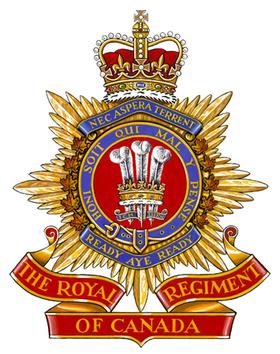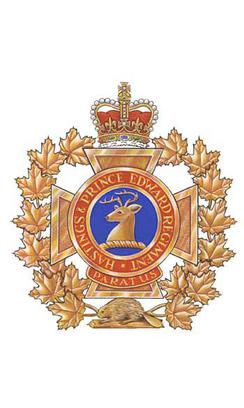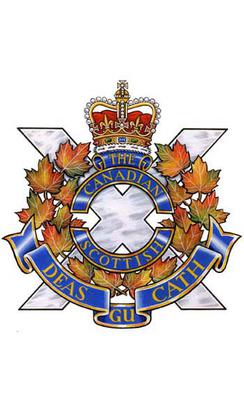Related Research Articles

The Royal Regiment of Canada is a Primary Reserve infantry regiment of the Canadian Army. The regiment is based in Toronto, Ontario, and forms part of the 4th Canadian Division's 32 Canadian Brigade Group.

The 1st Canadian Division is a joint operational command and control formation based at CFB Kingston, and falls under Canadian Joint Operations Command. It is a high-readiness unit, able to move on very short notice, and is staffed and equipped to meet Canada's military objectives to counter any potential threat.

The Canadian Grenadier Guards (CGG) is a reserve infantry regiment in the 34 Canadian Brigade Group, 2nd Canadian Division, of the Canadian Army. The regiment is the oldest and second-most-senior infantry regiment in the Primary Reserve of the Canadian Army. Located in Montreal, its main role is the provision of combat-ready light infantry troops in support of Canadian regular infantry. It is a Household Foot Guard regiment and also provides soldiers for public ceremonial duties, performing similar ceremonial duties as the Guards regiments of the British Army. This primarily entails mounting the guard at Government House, the King's and Governor General's residence, and performing the "Changing the Guard" ceremony on Parliament Hill in Ottawa, a task it shares with Canada's senior Household Foot Guard regiment, the Governor General's Foot Guards of Ottawa. The Canadian Grenadier Guards is an allied regiment to the British Grenadier Guards.
The Canadian Expeditionary Force (CEF) was the expeditionary field force of Canada during the First World War. It was formed on August 15, 1914 following Britain’s declaration of war on the German Empire, with an initial strength of one infantry division. The division subsequently fought at Ypres on the Western Front, with a newly raised second division reinforcing the committed units to form the Canadian Corps. The CEF and corps was eventually expanded to four infantry divisions, which were all committed to the fighting in France and Belgium along the Western Front. A fifth division was partially raised in 1917, but was broken up in 1918 and used as reinforcements following heavy casualties.

The Royal Hamilton Light Infantry (Wentworth Regiment) (RHLI) is a Primary Reserve infantry regiment of the Canadian Army, based at John Weir Foote VC Armoury in Hamilton, Ontario. The RHLI is part of 31 Canadian Brigade Group, which is part of 4th Canadian Division.

The Hastings and Prince Edward Regiment is a Primary Reserve infantry regiment of the Canadian Army. The regiment is part of 33 Canadian Brigade Group, one of four brigade groups of 4th Canadian Division. The regimental headquarters and one company are at 187 Pinnacle Street in Belleville and on Willmott Street in Cobourg, with another rifle company in Peterborough. The Peterborough Armoury houses what was traditionally B Company or Moro Company. Moro Company also serves as the headquarters for the regiment’s Assault Pioneer Platoon. Normally, the regiment deploys as a composite, Ortona Company, while the headquarters and administration form Somme Company.

The Brockville Rifles is a Primary Reserve infantry regiment of the Canadian Army. The unit is a part of the 33 Canadian Brigade Group, 4th Canadian Division. It is fifteenth in the order of precedence of Canadian Army Infantry Regiments.

The Royal Winnipeg Rifles are a Primary Reserve one-battalion infantry regiment of the Canadian Army. Nicknamed the "Little Black Devils", they are based at Minto Armoury in Winnipeg, Manitoba. The Royal Winnipeg Rifles are part of 3rd Canadian Division's 38 Canadian Brigade Group.

The Algonquin Regiment (Northern Pioneers) is a primary reserve infantry regiment of the Canadian Army comprising two companies. A Company is in North Bay, Ontario, and B Company is in Timmins, Ontario. The regiment falls under the command of the 4th Canadian Division's 33 Canadian Brigade Group.

The Canadian Scottish Regiment (Princess Mary's) is a Primary Reserve infantry regiment of the Canadian Army based on Vancouver Island in British Columbia.
The 123rd Battalion, Royal Grenadiers, CEF was a unit in the Canadian Expeditionary Force during the First World War. Based in Toronto, Ontario, they began recruiting in November 1915. After arriving in England, they continued to train as an infantry battalion for several months, but just before mobilizing to France in January 1917, the battalion was redesignated the 123rd Pioneer Battalion, Royal Grenadiers, CEF.
The 129th (Wentworth) Battalion, CEF was a unit in the Canadian Expeditionary Force during the First World War. Based in Dundas, Ontario, the unit began recruiting in late 1915 in Wentworth County. After sailing to England in August 1916, the battalion was absorbed into the 123rd and 124th Battalions, CEF and the 12th Reserve Battalion in October 1916. The 129th (Wentworth) Battalion, CEF had one Officer Commanding: Lieut-Col. W. E. S. Knowles.

The 159th Battalion, CEF was a unit in the Canadian Expeditionary Force during the First World War. Based in Haileybury, Ontario, the unit began recruiting in late 1915 in the districts of Nipissing and Sudbury. After sailing to England in November 1916, the battalion was absorbed into the 8th Reserve Battalion on January 20, 1917. The 159th Battalion, CEF had one Officer Commanding: Lieut-Col. Ernest Frederick Armstrong.

Permanent Active Militia (PAM), also known as Permanent Force (PF), was the proper name of Canada's full-time professional land forces from 1855 to 1940, when it was reorganized into the Canadian Army. PAM was in effect Canada's standing army, consisting of one regular infantry regiment and two cavalry regiments in 1914.
The 256th Battalion, CEF was a unit in the Canadian Expeditionary Force during the First World War. Based in Toronto, Ontario, the unit began recruiting in late 1916 in that city. The unit later became the 10th Battalion, Canadian Railway Troops. The battalion received no battle honours and was disbanded on 15 September 1920. The 256th Battalion, CEF had one Officer Commanding: Lieut-Col. W. A. McConnell.
The 109th Battalion CEF was a unit of the Canadian Expeditionary Force, the men of which saw active service during the First World War.
124th may refer to:

The Otter Commission, or Otter Committee, was established after the First World War to tackle a problem created by the chaotic mobilization of the Canadian Expeditionary Force. In 1919, units of the CEF, intended as a wartime expeditionary force, returned to Canada where the Canadian Militia had served during the war performing home defence duties, staffing internment camps, and raising recruits for overseas. Both the CEF and the Militia desired to be perpetuated in the post-war world. The CEF units were proud of their wartime record, while the pre-war Militia had long-standing roots in the community and battle honours dating back as far as the War of 1812.
The Victoria and Haliburton Regiment was an infantry regiment of the Non-Permanent Active Militia of the Canadian Militia. In 1936, the regiment was converted from infantry to artillery to become the 45th Field Battery RCA and now forms part of the 50th Field Artillery Regiment, RCA.
The Toronto Regiment was an infantry regiment of the Non-Permanent Active Militia of the Canadian Militia. The regiment was formed in 1920 when the war-raised 3rd Battalion of the Canadian Expeditionary Force was incorporated after the First World War into the post-war Canadian Militia. In 1936, the regiment was amalgamated with The Royal Grenadiers to form The Royal Regiment of Toronto Grenadiers.
References
- ↑ "Other Pioneer Battalions of the CEF". Russians in the CEF. Peter Broznitsky. Retrieved 26 October 2024.
- Meek, John F. Over the Top! The Canadian Infantry in the First World War. Orangeville, Ont.: The Author, 1971.